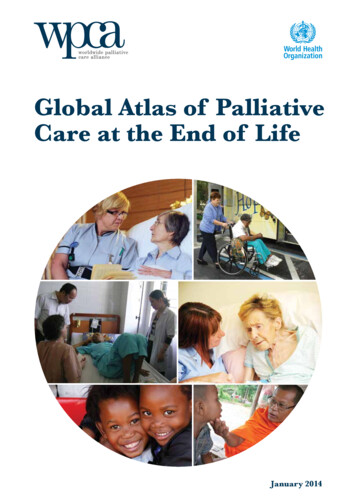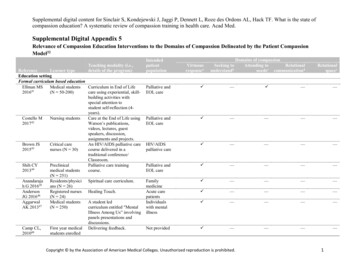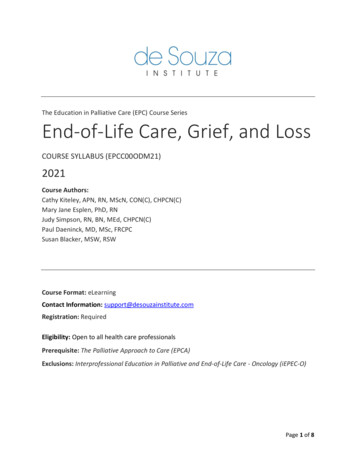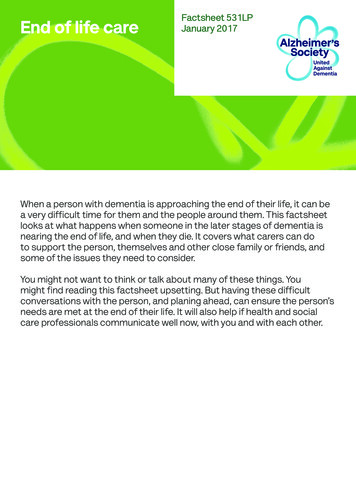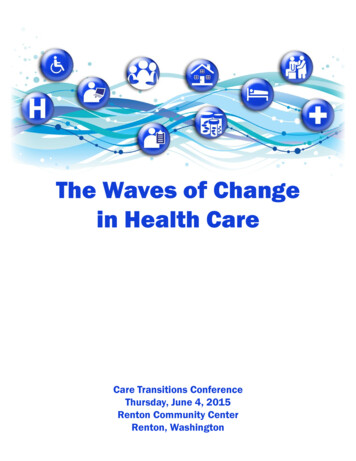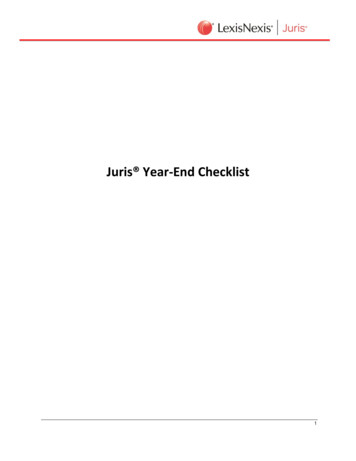
Transcription
PALLIATIVE CARE IN THE END STAGERENAL DISEASE (ESRD) POPULATION:BEYOND THE BASICS AND INTO THE FUTUREDaniel Sturgill MD and Alexandria Bear MD20 April 2018
CONFLICTS OF INTERESTWe have no financial or other conflicts of interest to disclose
“Palliative Care is an approach which improves the quality of life of patientsand their families facing life-threatening illness, through the prevention andrelief of suffering by means of early identification and impeccable assessmentand treatment of pain and other problems, physical, psychosocial andspiritual.”- WHO definition (2002)
“Palliative Care is an approach which improves the quality of life of patientsand their families facing life-threatening illness, through the prevention andrelief of suffering by means of early identification and impeccable assessmentand treatment of pain and other problems, physical, psychosocial andspiritual.”- WHO definition (2002)Patients with ESRD have a life-threatening illness that is nearly alwaysidentified very early and they have an illness course that is typically filledwith a multitude of problems be they physical, psychosocial, or spiritual
GEORGEGeorge is an 68 year old male who has lived with diabetes for the past 18 years. He hasdeveloped diabetic nephropathy with chronic kidney disease. He has been following with hisnephrologist and the plan was to eventually proceed with hemodialysis. Over the past threeyears, his renal function has declined progressively to the point of end-stage renal disease.George meets with his nephrologist and decides to proceed with thrice weekly hemodialysis.
OBJECTIVES1. Provide background on the epidemiology of end-stage renal disease and dialysis utilization2. Describe care models for incorporation of palliative care services for nephrology patients3. Explore symptom management considerations in the setting of renal failure4. Discuss hospice utilization for the ESRD patient population
OUTLINE1.ESRD Epidemiology2.Changes in the ESRD population over 50 years3.Average day for an average ESRD patient4.Clinical course and prognosis5.Hospice care for the ESRD patient6.Symptom management- special considerations in the ESRD patient7.The current (lack of) palliative nephrology approach8.The future: models to integrate palliative medicine and nephrology care for those with ESRD
ESRD PREVALENCE1980-2015USRDS ESRD Database
Survival rates from time of dialysis initiation 76% 1 year 36% 5 yearESRD CLINIC AL COURSEAND PROGNOSIS Mortality 2x that of cancer, CHF, or CVA Older patients with greater morbidity andmortality For those 85 years old Median survival 6 months 1/3 of that time spent in the hospital
EVOLUTION OF THE “TYPICAL” ESRD PATIENT 1972: United States ESRD program started Prior: ESRD universally fatal Population: Healthy Sick People are living long enough to get sick fromother things High symptom burden1 Edmonton Symptom Assessment System (ESAS): Mean of 7.5 /- 2.5 symptoms 4.5 are severe symptomsJay L. Xue et al. JASN 2001;12:2753-27581Davisonet al. Kidney International. 2006; 69(9):2621-5.
Rehab or bridge to transplant — Prolong life One-half of dialysis patients 65 years-oldHOW HAS THE ESRDPOPULATION CHANGEDSINCE 1972? 75% increase in incident ESRD over last 20years! Survivorship remains poor 36% 5 year survival in all patients 25% 5 year survival in people 75 years-old
ADJUSTED ALL-C AUSE MORTALITYUSRDS ESRD Database
ESTIMATING 6 MONTH MORTALITYFOR PATIENTS ON MAINTENANCE HEMODIALYSIS Lack of clinical tools available for prognostication leads to fewer discussions about prognosis Cohen et al (2010) Actuarial data clinician prediction (surprise question) Appeared to be a terrific tool for predicting mortality (AUC 0.87 derivation cohort, 0.80 in validation cohort)Forzley et al (2017) - Cohen model overpredicted mortality in a Canadian cohort
NEWEST MORTALITYPREDICTION MODEL
COUNSELING ELDERLY PATIENTSREGARDING DIALYSIS INITIATION70-79 Years Old 80 Years Old** No survival advantage among patients age 80 choosing dialysis over conservative managementClin J Am Soc Nephrol. 2016;11:633-40.
DIALYSIS JOB DESCRIPTION Full time No vacation Expected to work from home 7.5 symptoms - 4.5 severe(Edmonton Symptom Assessment System) Business trips - several weeks per year
A DAY IN THE LIFE Wake up at 05:00 Monday/Wednesday/Friday Either drive self or receive transportation 10-15 minutes in waiting room 4 hours of dialysis* Either drive self or receive transportation Fatigue post-dialysis and recover remainder of day Feel well the next day Repeat* The process works with industrial efficiency at hemodialysis unitshttps://www.kidney.org
HOSPITAL DAYS FOR ESRD PATIENTS2006-2015USRDS ESRD Database
ESRD AND HOSPICE UTILIZATION 20% of dialysis patients utilize the hospice benefit Compared with . 55% of those with cancer 39% of those with heart failure Utilization is generally in the last days of life 18% of maintenance hemodialysis patients preferred to live as long as possible evenif it meant suffering 45% of dialysis patients die in the hospital Versus 35% of Medicare beneficiaries with other severe illness(CHF, ESLD, dementia, COPD) 9.8 days in hospital in last month of life
ESRD HOSPICE CRITERIANeph News and Issues. 2016.
GEORGEGeorge underwent arteriovenous fistula placement and was able to initiate dialysis in theoutpatient setting. He has remained on hemodialysis for the past two years.Over the last week, he developed shortness of breath and presented to the ER. He wasfound to have what looks like an infiltrate on his chest x-ray.He was admitted to the hospital for IV antibiotics for pneumonia.
HOSPITAL ADMISSIONS IN LAST 90 DAYS OF LIFE2 0 0 0- 2014USRDS ESRD Database
HOSPITAL ADMISSIONS WITH PROLONGED STAYSUSRDS ESRD Database
HOW DO ESRD PATIENTS DIE?Unadjusted percentages ofdeaths in 2014 by cause
HOW DO ESRD PATIENTS DIE?Unadjusted percentages ofdeaths in 2014 by cause
UTILIZATION OF HOSPICERESULTS IN COST REDUCTIONUSRDS ESRD Database
GEORGEGeorge remains admitted for three days without improvement in his respiratory status.A CT scan is performed and demonstrates a large lung mass concerning for malignancywith evidence of widely metastatic disease in the liver, lymph nodes, and bones.Palliative care is consulted to discuss goals of care with George and his family. George isconsidering a transition to a comfort plan of care, including consideration of stoppingdialysis, but is worried about what symptoms may arise from his renal failure
1. Pain2. DyspneaSYMPTOM MANAGEMENTCONSIDERATIONS3. Pruritis4. Agitation5. Secretions6. Nausea and Vomiting
PAIN MANAGEMENTGENERAL CONSIDERATIONS Utilize a step-wise approach based on the WHO ladder Similar to non-ESRD patients Non-opioid analgesics Acetaminophen is the non-narcotic choice Limit NSAIDs Further renal impairment, hypertension, edema, hyperkalemia can result Consider opioid pharmacokinetics Morphine metabolites are renally cleared Use can result in opioid toxicity Avoid in ESRD patientPall Med. 2010; 23.
PAIN MANAGEMENTOPIOID CONSIDERATIONSTramadolOxycodoneMorphine- Maximum dose 50 mg BID- Safer than morphine due to hepatic metabolism- Excreted in urine start at lower dose and frequency- Metabolites accumulate and can cause toxicity- Metabolite (hydromorphone-3-glucuronide) can accumulateHydromorphone - Fewer side effects than morphine, however anecdotal evidence with safety concerns- Use with caution in ESRD patientsFentanylMethadone- Dose similar to patents with normal renal function- Shortest acting- Metabolism may be impacted by renal impairment, dose reduce 50-75%- Recommend specialist involvement
PAIN MANAGEMENTADJUVANTSGabapentin- Adjunct for neuropathic pain- Elimination directly related to GFR- 35% removed during hemodialysisAnticonvulsants- Adjuncts for neuropathic pain- Data limited in ESRD patients, therefore consider specialized dosing for ESRD patientsAntidepressants- Tricyclics: significant adverse effects (sedation, anticholinergic) despite hepatic metabolismCorticosteroids- Same considerations as patients with normal renal functionAm J Kidney Dis. 2003; 42.
DYSPNEA Multifactorial etiology Inflammation associated with the active dying process Volume overload associated with renal disease Opioid considerations same as those described for pain Utility of diuretics? Can have efficacy in volume removal if patient making urine Requires a high dose (can estimate 20 x creatinine) Remind patients about stopping lab monitoring
PRURITIS Secondary symptom with multifactorial etiology 2o hyperparathyroidism, hyperphosphatemia, calcium deposition, dry skin Primary management: Xerosis: Emollients Anti-histamines UVB light (2-3 times per week) Alternative interventions without clear evidence base Gabapentin: Dosing limited in ESRD Capsaicin: Burning may be problematic Cholestyramine: May impact absorption of other medications
TERMINAL AGITATION AND ANXIETY Evidence base limited, therefore based on expert consensus Benzodiazepines: More unbound medication available and can cause drowsiness If utilized would require dose reduction Most benefit from antipsychotic medications Haloperidol recommendedPal Med. 2009; 23.
TERMINAL SECRETIONS Treat only if causing patient discomfort Loud secretions can be distressing for care providers and family Recommend utilization of medications that do not cross the blood brain barrier Can cause paradoxical agitation in the setting of uremia Medication options similar to other patients Atropine drops Glycopyrrolate Can accumulate in the setting of renal impairment Start at 50% normal starting doseBr J Anaest. 1993; 71.
NAUSEA AND VOMITING Uremia induced nausea due to stimulation of chemoreceptor trigger zone Recommended first line drug: Haloperidol Metabolites may accumulate Start at 50% of normal dose Second line: Chlorpromazine Avoid use of Metoclopramide Increased incidence of extrapyramidal reactionsPall Med. 2010; 23.
DOES USE OF ERYTHROPOIETIN STIMULATING AGENTSCONTRIBUTE TO COMFORT? Retrospective cohort study in Hong Kong – 2011-2013 Non-dialysis palliative careESA versus non-ESA control over 6 monthsBaseline: 91% patients fatigued, 83% moderate-severely fatiguedESA group (6 months) Improvement in fatigue (P 0.05)Reduced hospitalizations per patient year (4.4 versus 9.2, P 0.001) Expensive – Medicare spends 2B annually (10% ofESRD spending)Int Urol Nephrol (2014) 46:653–657
GEORGEGeorge elects to transition to a comfort plan of care and enrolls in home hospice.He initially develops nausea and agitation which is effectively managed with haloperidol.Over the subsequent days, he also develops dyspnea and requires initiation of IVhydromorphone.He dies 9 days after enrolling in home hospice.
THE IDEAL:SHARED DECISION-MAKING IN ESRD
IS THIS AN ISSUE OF IMPROVING THE INFORMEDCONSENT PROCESS FOR DIALYSIS? Study of patients on maintenance dialysis: 30% said risks/benefits of HD were described to them 1% recalled option of conservative therapy Boston study of dialysis patients: Zero patients reported having a discussion of prognosis Canadian study: 61% of patient regretted dialysis One half reported starting dialysis because it was the nephrologist’s wish National survey of nephrology fellows: 1 in 5 felt obligated to offer dialysis toevery patient, regardless of benefit (or lack thereof)Clin J Am Soc Nephrol. 2017;12:1001-9.
THE DISCONNECTBristowe et al. 2014.
THE CURRENT (DEFICIENCY OF)PALLIATIVE NEPHROLOGY(c) Fresenius Medical Care
PATIENT-BASED CHALLENGES:LOW ADVANCE DIRECTIVE COMPLETION RATEUSRDS ESRD Database
“Patient is not ready for palliative care,”“Doesn’t need palliative care”– NephrologistPROVIDER-B ASEDCHALLENGES “We thought every patient would be dying,”– Office staff Apprehension toward practice changes Operational challenges- ( )JPSM. 2018;55(1).
Renal Supportive Care (RSC) Clinics inSydney, AustraliaA PALLIATIVE NEPHROLOGYCLINIC MODEL Palliative physician or APP, nephrologist,social worker 30 minute time slots Innovative model comprehensive care withfocus on QOL, conservative (non-dialytic)management Improved symptom control, QOL
AUSTRALIAN OUTPATIENT KIDNEYPALLIATIVE CARE MODEL
Implement Australian model in the USA Stakeholder needs: “Symptom management is low hanging fruit”– NephrologistBUILDING AN OUTPATIENTPROGRAM “Normalize palliative services for HDpatients”– Dialysis RN “What are these patients told when HD isstarted? They seem unprepared”– Palliative nurse practitioner Determining work flowJPSM. 2018;55(1).
JPSM. 2018;55(1).
JPSM. 2018;55(1).
REFERENCES Brennan F, et al. Time to improve informed consent for dialysis: an international perspective. Clin J Am Soc Nephrol. 2017; 12(6): 1001-9. Bristowe K, et al. The development and piloting of the REnal specific Advanced Communication Training (REACT) programme to improve advance care planning for renal patients. Palliat Med. 2014; 28(4): 360-6. Chan KY, et al. Effect of erythropoiesis-stimulating agents on haemoglobin level, fatigue, and hospitalization rate in renal palliative care patients. Int Urol and Nephrol. 2014; 46(3): 653-7. Cheng HW, et al. Use of erythropoietin-stimulating agents (ESA) in patients with end-stage renal failure decided to forego dialysis: palliative perspective. Am J Hosp Palliat Care. 2017; 34(4): 380-4. Cohen LM, Ruthazer R, Moss AH, and Germain MJ. Predicting six-month mortality for patients who are on maintenance hemodialysis. Clin J Am Soc Nephrol. 2010; 5(1): 72-9 Davison SN, Jhangri GS, Johnson JA. Cross-sectional validity of a modified Edmonton symptom assessment system in dialysis patients: A simple assessment of symptom burden. Kidney International. 2006;69(9): 1621-5. Douglas C, et al. Symptom management for the adult patient dying with advanced chronic kidney disease: A review of the literature and development of evidence-based guidelines by a United Kingdom ExpertConsensus Group. Pal Med. 2009; 23: 103-10. Forzley B, et al. External validation and clinical utility of a prediction model for 6-month mortality in patients undergoing hemodialysis for end-stage kidney disease. Palliat Med. 2017. Epub ahead of print. Jay L. Xue et al. Forecast of the Number of Patients with End-Stage Renal Disease in the United States to the Year 2010. JASN. 2001;12: 2753-2758. Kirvela M, Ali-Melkkila T, Iisalo E, and Lindgren L. Pharmacokinetics of glycopyrronium in uraemic patients. Br J Anaesth. 1993; 71: 437-9. Kurella M, Bennett WM, and Chertnow GM. Analgesia in patients with ESRD: A review of available evidence. Am J Kidney Dis. 2003; 42: 217-28. Massry SG, et al. Intractable pruritic as a manifestation of secondary hyperparathyroisidm in uremia. N Eng J Med. 1968; 279: 697. Murtagh FEM, et al. Symptom management in patients with established renal failure managed without dialysis. EDTNA ERCA Journal. 2006. 93-98. Parfitt AM, et al. Disordered calcium and phosphorous metabolism during maintenance hemodialysis. Am J Med. 1971; 51: 319. Russell JS, et al. Providing supportive care to patients with kidney disease. Neph News & Issues. 2016; 30: 28–30. Scherer JS, Wright R, Blaum CS, and Wall SP. Building an outpatient kidney palliative care clinical program. JPSM. 2018; 55(1): 108-16. United States Renal Data System. 2017. https://www.usrds.org/adr.aspx. Accessed January 2018. Verberne WR, et al. Comparative survival among older adults with advanced kidney disease managed conservatively versus with dialysis. Clin J Am Soc Nephrol. 2016; 11(4): 633-40. Wick JP et al. A clinical risk prediction tool for 6-month mortality after dialysis initiation among older adults. Am J Kidney Dis. 2017; 69(5): 568-75. Ch
QUESTIONS?https://c1.staticflickr.com
Provide background on the epidemiology of end-stage renal disease and dialysis utilization 2. Describe care models for incorporation of palliative care services for nephrology patients . People are living long enough to get sick from other things High symptom burden1 . Feel well
